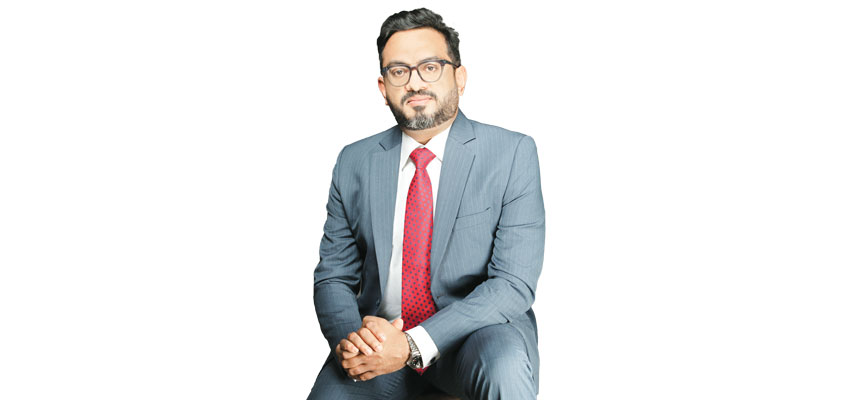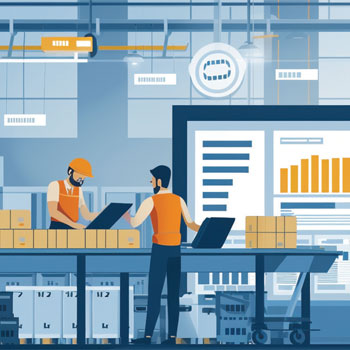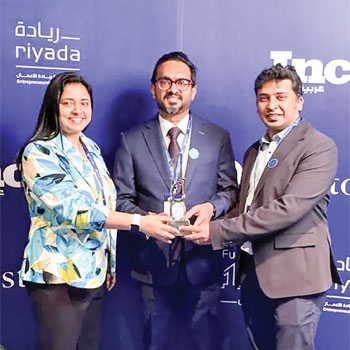RESOLVING THE Counterfeit Conundrum

Counterfeiting is not just about money anymore—it now affects medicine, cosmetics, alcohol and even baby milk. While grey markets thrive, innovators like Padmakumar Nair, founder and CEO, Ennoventure Inc., are tackling the issue.
It all began at The Sloan School of Management at the Massachusetts Institute of Technology (MIT Sloan), while pursuing an Executive MBA. A startling statistic, stating that Africa witnesses a child dying from malaria every five minutes due to counterfeit antimalarial drugs, triggered the need for a solution. The concern drove Nair and his classmates to develop invisible cryptographic signatures to combat counterfeit medicines.
What began as an academic project for Padmakumar Nair, has gradually shaped his vision into a company partnering with global brands across industries. The company integrates anti-counterfeiting solutions into supply chains, packaging, and labelling, ensuring product authenticity. He shares his journey with Corporate Citizen, providing further insights into the sector – that thrives on AI and blockchain technology
Corporate Citizen: How has the experience in MIT Sloan, contributed to your career growth?
Padmakumar Nair: MIT transformed my outlook on education. Rather than viewing it to secure a better job and salary, I learned that education empowers us to create jobs and become entrepreneurs. Therefore, when I founded my company, we moved away from rigid performance management practices, including the bell curve and annual operating plans, and embraced a simpler system with quarterly targets. This approach encourages our team to push beyond predefined limits. More importantly, we prioritise cultivating a positive workplace culture—one where leadership is rooted in trust and empowerment, and people have the freedom to innovate without insecurity. Besides, exposure to platform-based business models at MIT further deepened my appreciation of their transformative potential.
CC: How big is the problem of counterfeit products globally and in India?

The issue of counterfeit products is immense, globally and in India. It trades fake goods representing hundreds of billions of dollars annually, significantly impacting economies and consumer safety. India, with its vast consumer base and complex supply chains, is a substantial part of the problem, particularly across pharmaceuticals and automotive spare parts sectors. The rise of e-commerce has further exacerbated the issue, making it easier for counterfeiters to reach consumers worldwide.
CC: Has technology made counterfeiting easier?
Technology has enabled high-quality digital reproduction of packaging and labels, particularly facilitating widespread online distribution of counterfeit goods through e-commerce platforms and social media. The accessibility to advanced tools and global marketplaces lowers the barriers for counterfeiters to operate.
CC: How are counterfeiters using AI to create fake products?
Counterfeiters are increasingly utilising AI to streamline and enhance their operations. AIpowered image recognition allows for rapid replication of intricate packaging designs and logos, while generative AI creates convincing counterfeit product images and videos for online listings. Machine learning algorithms analyse market trends that identify high-demand items suitable for counterfeiting. Additionally, AI-driven chatbots and social media bots automate the distribution of counterfeit products and engage with potential buyers, effectively scaling their reach and impact. AI empowers counterfeiters to create more convincing fakes and efficiently reach a wider audience.
CC: Why is the FMCG sector particularly vulnerable, and what are the possible consumer risks?

The FMCG sector is highly vulnerable due to its high demand, widespread distribution and low unit prices, making counterfeiting profitable and easier to infiltrate. The diverse product range also complicates tracking and authentication, further increasing its susceptibility. Counterfeit FMCG products pose significant risks to consumers, including exposure to harmful or ineffective ingredients that can cause health problems. They also undermine consumer trust in brands, leading to financial losses due to the purchase of substandard goods.
CC: What are the anti-counterfeiting tech trends for the FMCG sector?
The FMCG sector is embracing advanced anticounterfeiting technologies to enhance product security and consumer trust. AI-driven authentication is enabling real-time fraud detection, while covert marking technologies make it harder for counterfeiters to replicate products. Blockchain-based track-and trace systems are ensuring end-to-end transparency in the supply chain, allowing stakeholders to verify authenticity at every stage. Additionally, brands are leveraging smartphone verification apps and QR code-based authentication to engage consumers in the authentication process. These innovations are transforming anti-counterfeiting efforts, making them more effective and consumer friendly.
CC: How are companies resolving the problem?
Faced with the escalating threats, companies have increasingly recognised the need for robust anticounterfeiting measures. The realisation, coupled with advancements in technology, has led to the development and adoption of various solutions, including advanced packaging, track-and-trace systems and digital authentication methods, enabling companies to protect their brands and consumers from the pervasive threat of counterfeiting.
"The tech and SaaS sectors combat counterfeiting with AI-driven pattern detection, blockchain for transparent traceability and digital fingerprinting for secure authentication. Invisible marking and consumer verification via QR codes or Near-field communication tags further enhance security"
CC: How serious is the problem of counterfeit pharmaceutical products?
It poses a significant threat to public health. The global trade in counterfeit drugs is a multi-billiondollar industry, impacting both developed and developing nations. It requires urgent attention from regulatory bodies and pharmaceutical companies. Fake medications can contain incorrect dosages, harmful ingredients, or no active ingredients at all, leading to treatment failure, adverse reactions or even death. The issue undermines trust in healthcare systems and pharmaceutical companies.
CC: Why is e-commerce a growing problem for counterfeiting?
E-commerce significantly exacerbates counterfeiting due to its global reach and anonymity. Online marketplaces offer counterfeiters direct access to vast consumer bases, bypassing traditional supply chain controls. The ease of setting up online storefronts and the ability to quickly distribute products globally, pose a challenge in tracking and intercepting counterfeit goods. Furthermore, the lack of physical inspection before purchase unknowingly increases the risk of consumers buying fakes. It creates a fertile ground for counterfeiters to thrive.
CC: Why are visible security features ineffective in stopping counterfeiting?
Visible security features, including holograms, watermarks and QR codes, are often ineffective against counterfeiting because they can be easily replicated with advancing technology.
Counterfeiters have access to sophisticated tools, allowing them to mimic these features with high precision. Additionally, consumers and supply chain stakeholders may lack the knowledge or tools to verify these features accurately. Over-reliance on visible measures without integrating advanced, invisible, or digital solutions, leaves brands vulnerable to increasingly skilled counterfeit networks.
CC: What is the shelf life of traditional anti-counterfeiting solutions?
The shelf life of traditional anti-counterfeiting solutions varies on the technology used and environmental factors, including adhesive quality, ink durability and exposure conditions. Holograms and security labels typically last between 2 to 5 years, depending on adhesive strength and external exposure. QR codes and barcodes can remain effective for 3 to 7 years if printed with high-quality ink. Radio-Frequency Identification (RFID) tags offer a longer lifespan of 5 to 10 years when properly embedded and protected. Security inks, including UV, thermochromic and photochromic variants, have a shelf life of 2 to 5 years based on their formulation and exposure. The longevity of these solutions is crucial in determining their effectiveness in combating counterfeiting, making it essential to choose the right technology for specific applications.
CC: What is the USP of your company?
Our company specialises in covert brand protection, utilising AI and cryptography to combat product counterfeiting across industries like FMCG, automotive, consumer electronics and pharmaceutical. Founded in 2018 by me and Shalini Nair, when we recognised the growing threat of counterfeiting, particularly in the digital age. The company offers a non-disruptive solution that embeds an imperceptible cryptographic signature onto packaging, enabling smartphonebased authentication. Our patented technology addresses the critical need for robust product verification without altering existing packaging or printing processes, based on our mission to safeguard product integrity and intellectual property in an evolving market.
CC: How does your technology enable brands to track counterfeiters?
Our technology primarily focuses on verifying product authenticity through covert cryptographic signatures and smartphonebased authentication. While it provides a strong deterrent against counterfeiting and helps to identify potentially fake products, it does not enable a direct real-time tracking of counterfeiters in the way that, let's say, a GPS tracking system would. However, by providing authentication data, it contributes to the overall picture of where counterfeit goods are appearing, enabling brands to use the data for their investigations.
CC: What makes your anti-counterfeiting technology unique?
Our technology uniquely embeds an invisible cryptographic signature, directly into existing packaging, requiring no design changes. Although, the signature is undetectable to the naked eye, we can authenticate it using a standard smartphone and the Vyu app—a mobile app that allows consumers and businesses to verify a product’s authenticity quickly and easily, through our covert technology, preventing the sale and distribution of counterfeit goods, maintaining integrity of the supply chain. By scanning products, users can instantly confirm their legitimacy and access real-time information, including general guidelines, detailed product specifications and usage instructions.
CC: What triggered the need to harness Software as a Service-based (SaaS) to fight product counterfeiting?
I am a firm believer in continuous upskilling and staying ahead in an evolving industry. As an early adopter, I actively explore emerging trends, evaluate their potential impact, and encourage my team to experiment without the fear of failure. The same mindset helped us render a SaaS-based service when we recognised the rapid shift towards digital transformation. We identified the opportunity to offer scalable and efficient solutions, by staying informed, and proactively testing innovative technologies. We positioned the business in the SaaS space, ensuring it remains future-ready and competitive.
"Visible security features including holograms, watermarks and QR codes are often ineffective against counterfeiting because they can be easily replicated with advancing technology. Counterfeiters have access to sophisticated tools, allowing them to mimic these features with high precision "
CC: How has the SaaS service sectors responded to the counterfeiting challenges?
The tech and SaaS sectors combat counterfeiting with AI-driven pattern detection, blockchain for transparent traceability, and digital fingerprinting for secure authentication. Invisible marking and consumer verification via QR codes or Near-field communication tags further enhance security. These technologies create a multi-layered defence, ensuring trust and product integrity.
The SaaS-based brand protection technology in India is still emerging, but holds immense potential. There is a growing awareness among brands about the need for strong digital protection, yet adoption remains limited due to cost sensitivity and limited understanding of the solutions available. There is a significant opportunity to innovate and educate the market, positioning ourselves as pioneers in this evolving space.
CC: How can AI help to fight counterfeiting?
AI can analyse vast datasets of authentication scans, identifying patterns and anomalies that indicate counterfeit activity, especially crucial in e-commerce. AI algorithms can detect subtle variations in authentication data that human eyes might miss, flagging suspicious products or sellers. This allows brands to pinpoint and address counterfeit hotspots within online marketplaces. Furthermore, AI enhances the robustness of cryptographic signatures, making them more resistant to replication by counterfeiters, thus strengthening brand protection in the digital realm. It helps refine the signature embedding process, making it more powerful against sophisticated counterfeiting techniques. AI also enables the creation of sophisticated, adaptable security features that are harder for counterfeiters to replicate.
CC: How does blockchain tech help to overcome counterfeiting?
Blockchain technology provides a transparent and immutable record of a product's journey from origin to the consumer. Each product is assigned a unique digital identifier stored on the blockchain, enabling consumers and businesses to verify authenticity in real-time. This ensures trust and traceability across the supply chain.
CC: Do you also incorporate blockchain technology?
No, our core technology relies on AI and cryptography, to embed and verify signatures. While these technologies can be used in conjunction with blockchain, our existing solution does not explicitly use blockchain.
Blockchain technology is not the only reliable solution to overcome counterfeiting. While blockchain offers strong advantages in terms of traceability and data immutability, other technologies and strategies are also highly effective and often used in conjunction with blockchain.
CC: Why is brand protection important in today's market?
Brand protection safeguards reputation, consumer trust and revenue, by preventing counterfeit products from eroding market share and creating safety risks. It maintains product integrity and ensures a brand's long-term viability in a competitive landscape. It is about trust. If people buy fakes, they lose faith in the real brand. Plus, it hurts a company's reputation and bottom line.
CC: How can brands educate consumers about counterfeit risks?
Brands can educate consumers through clear labelling, online resources and social media campaigns, highlighting the dangers of fakes. They can also provide tools for easy product verification.
CC: How do you see the company’s future market growth?
The anti-counterfeiting tech market is growing rapidly due to e-commerce expansion and sophisticated counterfeiting tools. We therefore, aim to capture a significant market share within the next five years, becoming the preferred solution for robust, non-disruptive authentication.